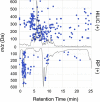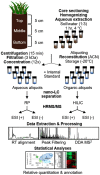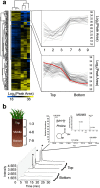Evaluation of an untargeted nano-liquid chromatography-mass spectrometry approach to expand coverage of low molecular weight dissolved organic matter in Arctic soil
- PMID: 30967565
- PMCID: PMC6456581
- DOI: 10.1038/s41598-019-42118-9
Evaluation of an untargeted nano-liquid chromatography-mass spectrometry approach to expand coverage of low molecular weight dissolved organic matter in Arctic soil
Abstract
Characterizing low molecular weight (LMW) dissolved organic matter (DOM) in soils and evaluating the availability of this labile pool is critical to understanding the underlying mechanisms that control carbon storage or release across terrestrial systems. However, due to wide-ranging physicochemical diversity, characterizing this complex mixture of small molecules and how it varies across space remains an analytical challenge. Here, we evaluate an untargeted approach to detect qualitative and relative-quantitative variations in LMW DOM with depth using water extracts from a soil core from the Alaskan Arctic, a unique system that contains nearly half the Earth's terrestrial carbon and is rapidly warming due to climate change. We combined reversed-phase and hydrophilic interaction liquid chromatography, and nano-electrospray ionization coupled with high-resolution tandem mass spectrometry in positive- and negative-ionization mode. The optimized conditions were sensitive, robust, highly complementary, and enabled detection and putative annotations of a wide range of compounds (e.g. amino acids, plant/microbial metabolites, sugars, lipids, peptides). Furthermore, multivariate statistical analyses revealed subtle but consistent and significant variations with depth. Thus, this platform is useful not only for characterizing LMW DOM, but also for quantifying relative variations in LMW DOM availability across space, revealing hotspots of biogeochemical activity for further evaluation.
Conflict of interest statement
The authors declare no competing interests.
Figures






Similar articles
-
Spatial and molecular variations in forest topsoil dissolved organic matter as revealed by FT-ICR mass spectrometry.Sci Total Environ. 2023 Oct 15;895:165099. doi: 10.1016/j.scitotenv.2023.165099. Epub 2023 Jun 26. Sci Total Environ. 2023. PMID: 37379928
-
Extensive processing of sediment pore water dissolved organic matter during anoxic incubation as observed by high-field mass spectrometry (FTICR-MS).Water Res. 2018 Feb 1;129:252-263. doi: 10.1016/j.watres.2017.11.015. Epub 2017 Nov 7. Water Res. 2018. PMID: 29153878
-
Toward a More Comprehensive Approach for Dissolved Organic Matter Chemical Characterization Using an Orbitrap Fusion Tribrid Mass Spectrometer Coupled with Ion and Liquid Chromatography Techniques.Anal Chem. 2024 Mar 5;96(9):3744-3753. doi: 10.1021/acs.analchem.3c02599. Epub 2024 Feb 19. Anal Chem. 2024. PMID: 38373907 Free PMC article.
-
Molecular characterization of dissolved organic matter (DOM): a critical review.Anal Bioanal Chem. 2013 Jan;405(1):109-24. doi: 10.1007/s00216-012-6363-2. Epub 2012 Sep 11. Anal Bioanal Chem. 2013. PMID: 22965531 Review.
-
Effects of Dissolved Organic Matter on the Bioavailability of Heavy Metals During Microbial Dissimilatory Iron Reduction: A Review.Rev Environ Contam Toxicol. 2021;257:69-92. doi: 10.1007/398_2020_63. Rev Environ Contam Toxicol. 2021. PMID: 33977405 Review.
Cited by
-
An Automated Methodology for Non-targeted Compositional Analysis of Small Molecules in High Complexity Environmental Matrices Using Coupled Ultra Performance Liquid Chromatography Orbitrap Mass Spectrometry.Environ Sci Technol. 2021 Jun 1;55(11):7365-7375. doi: 10.1021/acs.est.0c08208. Epub 2021 May 18. Environ Sci Technol. 2021. PMID: 34006107 Free PMC article.
-
Local Phenomena Shape Backyard Soil Metabolite Composition.Metabolites. 2020 Feb 29;10(3):86. doi: 10.3390/metabo10030086. Metabolites. 2020. PMID: 32121389 Free PMC article.
-
CTP sensing and Mec1ATR-Rad53CHK1/CHK2 mediate a two-layered response to inhibition of glutamine metabolism.PLoS Genet. 2022 Mar 3;18(3):e1010101. doi: 10.1371/journal.pgen.1010101. eCollection 2022 Mar. PLoS Genet. 2022. PMID: 35239666 Free PMC article.
References
-
- Schuur EAG, et al. Vulnerability of permafrost carbon to climate change: Implications for the global carbon cycle. Bioscience. 2008;58:701–714. doi: 10.1641/b580807. - DOI
-
- Sjogersten S, et al. Organic matter chemistry controls greenhouse gas emissions from permafrost peatlands. Soil Biol. Biochem. 2016;98:42–53. doi: 10.1016/j.soilbio.2016.03.016. - DOI
-
- Yang Z, Wullschleger SD, Liang L, Graham DE, Gu B. Effects of warming on the degradation and production of low-molecular-weight labile organic carbon in an Arctic tundra soil. Soil Biol. Biochem. 2016;95:202–211. doi: 10.1016/j.soilbio.2015.12.022. - DOI
Publication types
LinkOut - more resources
Full Text Sources

